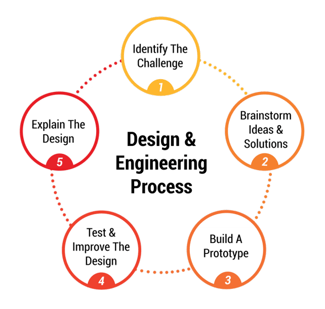.jpg?width=770&name=180919_KS-Shot-5_06-Final%20(16x9).jpg) Good news: Kids are already using the Design & Engineering Process
Good news: Kids are already using the Design & Engineering Process
That means your job is to simply help your kids understand what they're already doing naturally. Take a look at a few real-world examples of the Design & Engineering Process that kids are already involved in, and notice what these things all have in common.
 Kids regularly discover that everyday objects can be used in new and different ways. Maybe you’ve given kids paper towel rolls for a craft, only to see them repurposed as telescopes or megaphones before you’ve even brought out the paints and markers.
Kids regularly discover that everyday objects can be used in new and different ways. Maybe you’ve given kids paper towel rolls for a craft, only to see them repurposed as telescopes or megaphones before you’ve even brought out the paints and markers.
Or, have you watched kids with wood blocks, trying so hard to get them stacked just right, so they can build a HUGE tower. Focused on getting them positioned, carefully adding one piece at a time, little by little, working so hard, until finally...SUCCESS! And then what do they do? Knock it down! And they look so pleased!! What’s next? They do the whole thing again!
All of this commotion and chaos might drive us a bit batty from time to time, but the point is that THIS is what the Design & Engineering Process is all about. It takes kids' natural love of tinkering to the next level. The formula is simple and uses kids’ natural curiosity to drive learning by following a cycle of discovery.
Parts of it are new, most often labeled as STEM (science, technology, engineering, and math) education, but a lot of the Design & Engineering Process builds on what your kids are already doing. Your role is to help them understand what they're doing by pointing it out as it's happening. This way, kids will learn to intentionally use the process when faced with bigger challenges.
STEM activities for preschool and elementary school-aged kids
To better understand the Design & Engineering Process, let's look at a simple example of a STEM activity for preschool or elementary school-aged kids. I do this activity at the beginning of the year in my classroom, and have done versions of it with kids as young as TK all the way through 8th grade.
ACTIVITY: Work to build a structure out of aluminum foil. The only supplies needed are a roll of foil and a flat surface. (I suggest building on the floor for safety’s sake.)
Step 1: Identify the challenge
Start by asking a question. Kids are already asking questions in math, reading, and many other subjects; this question just focuses on solving a problem: “How can we build the TALLEST FREESTANDING tower out of aluminum foil?” Then, have the kids tell you what they understand to be the challenge (answer: build the tallest freestanding tower).
Step 2: Brainstorm ideas and solutions
Ask them to share their ideas. Write down as many as you can (or incorporate writing skills by having them first write down their ideas and then share). Remember, all ideas are ok at this point. This gives kids great practice at brainstorming for future activities like writing, and gives kids a chance for success because there is no "wrong" answer. Next, have the kids pick the most reasonable idea/design. Then, have them draw a picture/diagram and/or write instructions for how they will implement the chosen design.
Step 3: Build a prototype
Now ask them to go from the idea phase to the doing phase by actually building a tower based on their original idea. This is a great access point for struggling readers, English learners, and students with special needs as they can experience success on their own terms. In fact, many times they really shine during these activities.
Step 4: Test and improve (Pro tip: Failure is welcome!)
This is where the bulk of the learning takes place because kids will inevitably experience some kind of failure at this point. Their tower won’t stand, or it won’t be as tall as they wanted. The tinfoil might crumple or tear in a way they didn’t expect. Then, one of many things can happen. Some kids may experience frustration, but then channel that frustration into trying new ideas. Some may be deep in thought about what to do next. Some may just think of quitting. Encourage your kids to analyze why their design isn’t working the way they'd hoped, and then to look for ways to improve. That could mean sticking with what worked but improving the things that didn’t, or just starting from scratch.
This phase also helps kids build resilience by continuing to work on something even when they experience failure. All kids need to learn to be resilient if they are going to succeed in life as risk-takers and learners.
Step 5: Explain the design
Once kids have more or less successfully completed the challenge, ask them to explain how they developed their design, including the steps they followed in the Design & Engineering Process. This helps them reflect on what they did and how they learned from it. If you're working with multiple kids, it also helps them see that there can be different ways to solve a problem.
This foil tower activity, and other STEM or engineering activities, are great hands-on examples to show kids how important it is to try something more than once. Through this activity, they understand that almost nothing is perfect the first time around, and that making improvements is an ongoing process.
Engineering for kids is central to integrated learning
STEM activities are just another way to engage in the learning process. They use the innate curiosity kids have. All they need to do to be successful is to try, and be resilient if something fails. Barriers like language and reading levels are easily overcome. Students are doing. All YOU need to do is guide them, and encourage them to do their best, take risks, and have fun. And who knows...you might have some fun too!
.png?width=1270&height=453&name=Copy%20of%20Kid%20Spark%20Logo%20(Horizontal%20-%20Full%20Color).png)
